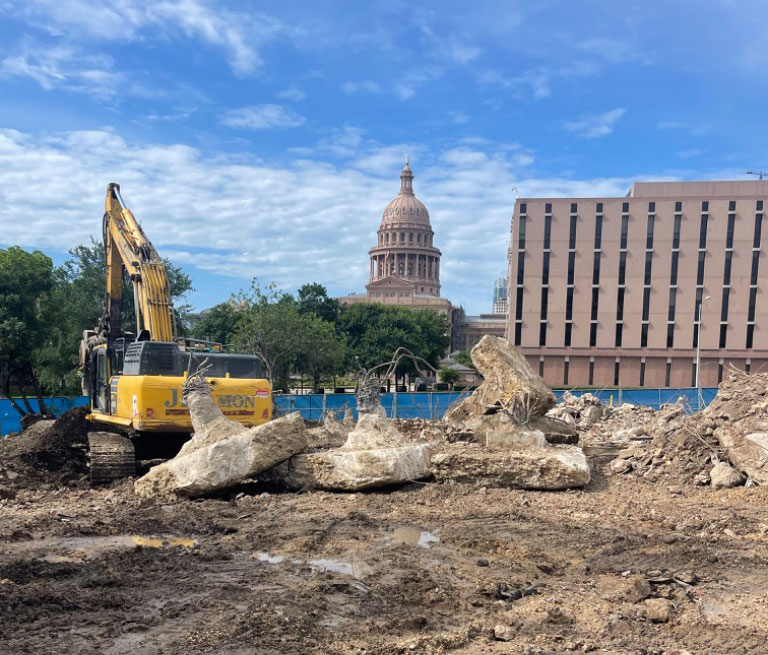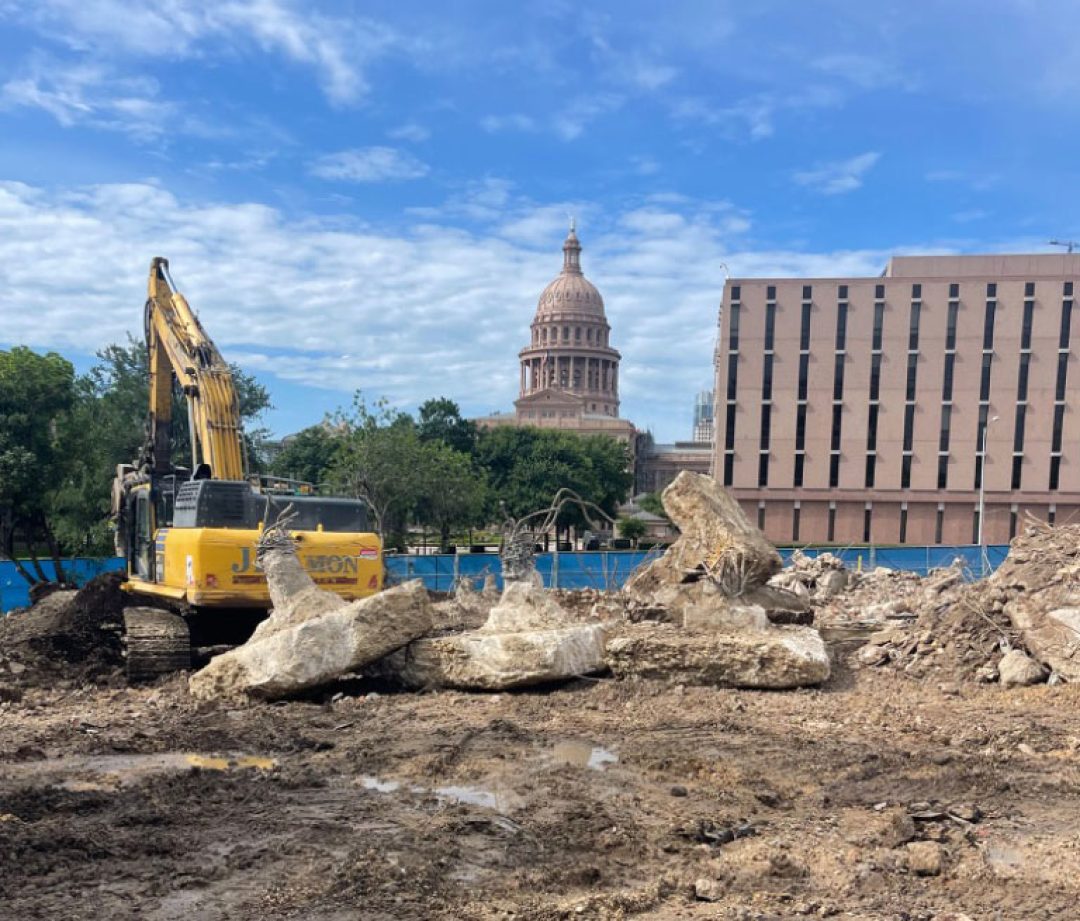
Photos courtesy of JR RAMON Demolition and the Texas Facilities Commission
This is the first edition of Team Spotlight, articles that will highlight the contributions of our team members for the completion of the historic Capitol Complex Project Phase II.
Before beginning excavation for the Phase II construction, one of the first site activities was the demolition of existing structures. The two city blocks of the Phase II project site included three structures, the former Capitol Complex Childcare Center, the former Capital Region District Office for the Texas Department of Public Safety, and a multi-purpose building. Through a competitive technical proposal process, JR RAMON Demolition was selected by Phase II prime contractor JE Dunn Construction for the project demolition tasks.
More Than 75 Years of Experience
 JR RAMON Demolition has been a Central Texas institution since 1945, when WWII veteran and purple heart recipient Joe Ramon, Sr. bought a dump truck and tractor and started an asphalt paving business. For the next twenty years, the business focused primarily on road projects. However, in 1968, the company completed their first demolition project as part of the construction team for the HemisFair Plaza.
JR RAMON Demolition has been a Central Texas institution since 1945, when WWII veteran and purple heart recipient Joe Ramon, Sr. bought a dump truck and tractor and started an asphalt paving business. For the next twenty years, the business focused primarily on road projects. However, in 1968, the company completed their first demolition project as part of the construction team for the HemisFair Plaza.
This iconic project changed the trajectory of the company. In 1971, JR RAMON received the first demolition license granted by the City of San Antonio, By the end of the decade, the company had fully switched their business model to demolition.
Since those early years, the family-based business has grown to more than one hundred employees by staying true to the core values of quality, safety, and providing career opportunities to the community. The company is headquartered in San Antonio and primarily serves the Central Texas area. JR RAMON is certified as a State of Texas historically underutilized business (HUB) and provides a wide range of demolition services for local, state, and federal agencies, including bridge demolition for TxDOT and urban site demolition for the University of Texas.
“Demolition projects are unique and require specialized training and safety measures,” says Timothy Ramon, president of JR RAMON. “There are many unknown conditions, including potential hazardous materials and dilapidated buildings that could collapse. It takes a minimum of ten years to become a demolition expert and the majority of our team have fifteen to forty years of experience.”
To ensure that every JR RAMON team member receives the required safety and quality training, the company maintains an extensive in-house training program. In celebration of the company’s 75th anniversary, the training program is now also offered to anyone from any company.

Precision Retrieval and Recycling as Standard Practice
Modern demolition involves using state-of-the-art equipment to physically remove structures and efficiently separate retrieved materials for recycling. JR RAMON customizes the equipment for the size and functionality required for specific tasks. For the demolition on Phase II, JR RAMON provided a six-man crew with two, large track excavators. The excavators have highly reinforced cabs and armored plating to protect both the operator and equipment from falling debris. The excavators are also equipped with hydraulic quick couplers that allow the operators to attach and detach different pieces of equipment without leaving the excavator cab. Some of the specialized attachments can break concrete while others can reach up to twelve stories to cut steel. The unique capabilities of this equipment provided safety and efficiency for the Phase II demolition.

The Phase II demolition work began by first removing the playground equipment from the former Child Care Center, which was locally donated for reuse. The demolition team then proceeded to break down the structures. More than 2,200 tons of recycled materials, mostly concrete, were retrieved from the site and taken to local recycling centers for repurposing. Much of the concrete retrieved from demolition projects is crushed for reuse as concrete aggregate for Texas Department of Transportation road projects. Ferrous metals are smelted and sold to create new building materials, such as rebar.

A Local HUB Clearing the Way for New State Office Buildings
Watching a building come down piece by piece can invoke nostalgia for past events and experiences and may seem like a negative act. However, to JR RAMON, demolition is about recycling, reusing, and making way for new growth.
Ramon explains, “We view our work as helping communities continue to develop. Once a building has outlived its useful life, we wipe the slate clean for new landmarks to be built. We recycle an average of eighty percent of the materials that we retrieve, and these materials are repurposed to serve the needs of the community.”
The demolition work for the Phase II project was completed within two months and allowed excavation work to proceed. “The State and JE Dunn placed their confidence in us, and we are proud to have delivered our services on this iconic project,” Ramon reflects. “We recognize that our certification as a State HUB has provided us opportunities to work on projects that have helped shape Texas. It is our honor to serve as a HUB, provide quality services at the highest safety standards, and offer career opportunities in Central Texas.”
We would like to thank JR RAMON Demolition and the members of their team for their contributions to the Capital Complex Phase II project and their continued service to the State of Texas. It was amazing to see the team in action and witness precision demolition practices.




